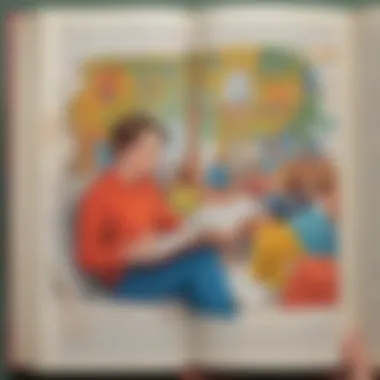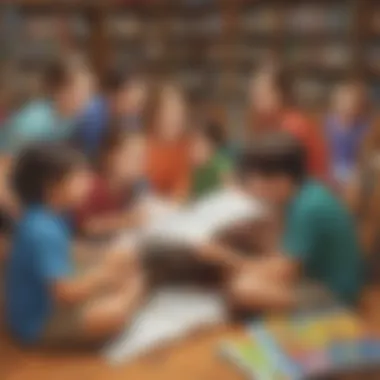Exploring the Role of Predictable Books in Early Literacy


Intro
Understanding the developmental phases of children is crucial, especially during the early stages of literacy. This period, often lush with exploratory enthusiasm, offers various avenues for engagement through reading. Predictable books serve as valuable tools, providing emergent readers with consistent text structures, rhythmic language patterns, and predictable storylines. This article analyzes the role of these books in breeding self-confidence and interest in literacy. We will explore their characteristics, memorable title recommendations, and discuss practical methods to integrate them effectively in learning activities, aiming to shape a nurturing literary environment.
Fun Activities Ideas
Engaging activities can immensely support the relationship your child develops with literacy, especially when leveraging predictable books. Here are some fun activities that maximize these benefits.
Indoor Activities
- Storytime puppet shows - Create puppets based on characters from predictable books and perform a show.
- Reading corners - Set up a cozy nook at home filled with predictable books, inviting frequent reading.
- Word wall creations - Select key words from the stories and create a wall display, allowing your child to visualize frequently used terms.
Outdoor Adventures
- Nature-inspired story walking - Take walks and gather items that relate to themes in the books you read together.
- Library expeditions - Organize regular trips to the library to choose new predictable books.
- Story scavenger hunts - Place items from the stories around your yard and have your child find them.
Arts and Crafts
Giving life to story elements through crafting is an engaging process:
- Character masks - Craft masks of favorite characters for imaginative play.
- Story diagrams - Let your child illustrate the main stories from these books using elements like plot, characters, and setting.
Science Experiments
Use predictable books as a launchpad for hands-on activities:
- Exploration of nature material - Pick leaves or look under rocks after connecting them with a book about nature.
- Mixed ingredients projects - If there is a book involving cooking, experiment with simple recipes.
Cooking and Baking
Preparing food together can illustrate themes from books:
- Themed snacks - Make snacks inspired by story elements or character traits learned from the predictable books.
- Edible crafts - Create craft items such as fruit faces based on the lessons from the stories.
Activities involving predictability in literature can reinforce awareness and create memory re-call among early readers.
To thrive in literacy skills, successful inclusion of fun activities around predictable literature ensures young minds do not only develop emergently but also enjoy this formative journey. In subsequent sections, we will delve deeper into educational games and other relevant strategies that support early literacy lessons.
Understanding Emergent Readers
Emergent reading is a foundational stage in the journey of literacy. Understanding emergent readers is essential for both educators and parents aiming to support children in their early reading experiences. This understanding can lead to effective strategies that promote engagement and foster a passion for reading.
In focusing on emergent readers, it is important to recognize not only their current skills but also their potential for growth. While reading skills develop at different paces, providing an environment conducive to learning will help ensure children become competent readers. This often includes recognizing the myriad ways infants and young children engage with text, even before they fully grasp the written word.
Defining Emergent Reading


Emergent reading refers to the period when children begin to understand that printed text conveys meaning. It encompasses the steps they take before reaching independent reading. Children at this stage might be able to identify letters, recognize their names, and enjoy listening to stories read aloud. Emergent reading captures the curiosity and enjoyment of text that pave the way for later skills like word recognition and comprehension.
Children's interaction with various forms of texts, including picture books and songs, forms the basis of their understanding. In many cases, they begin to recognize patterns, rhythm, and even the structure of stories through repeated exposure to readable environments.
Stages of Reading Development
Reading development is not a linear process. It typically consists of several overlapping stages, including:
- Pre-emergent Stage: At this stage, children explore books, flipping through pages and treating them as tactile creations. They learn about books through handling them and are intrigued by colored illustrations.
- Emergent Stage: This is when children understand that print has meaning. They may memorize short texts, identify familiar words, and some may even point to words while listening to stories. This stage sets the foundation for further reading advancement.
- Early Readers: In this stage, children begin to decode simple words and develop sight word recognition. They may start attempting to read simple sentences in predictable books, aided by context clues from pictures.
- Growing Readers: Children continue gaining skills as their vocabulary expands, encountering new story structures and subject matters, which enhances their comprehension abilities.
- Fluent Readers: By this phase, children read with increased comprehension and evaluation of texts. They begin to engage with a variety of genres.
Understanding these stages can guide educators and caregivers in selecting suitable materials and methods to nurture a child’s reading skills further. The foundation laid during the emergent reading phase is often crucial for developing long-term literacy skills. It promotes motivation towards reading as a pleasurable experience, paving the way for success in future academic endeavors.
“Early experiences with print create the groundwork for successful literacy development, fostering motivation and comprehension that last a lifetime.”
The Role of Predictable Books
Predictable books hold a significant place in the journey of emergent readers. Their structure and style cater directly to the needs of young learners by providing familiar patterns and Reinforcing skills necessary for reading development. When children encounter predictable texts, they begin to recognize that reading is not merely a necessary skill but a source of enjoyment and knowledge.
Moreover, such books enable children to engage through repeated reading. This not only builds confidence but allows them to anticipate what comes next, creating a sense of security in an activity that can otherwise be daunting. The repetition inherent in predictable texts fosters an early literacy foundation that significantly eases transition into more complex reading materials.
Another core aspect of predictable books is that they adapt well for various educational purposes. Teachers can utilize them in skill-building exercises such as phonemic awareness, word recognition, and even comprehension skills. Emphasis on practical application of language skills, particularly through engagement with these texts, maximizes their instructional potential.
Characteristics of Predictable Texts
Predictable books share a handful of key characteristics that make them ideal for emergent readers. First, they frequently employ repetitive text patterns. These patterns allow children to practice decoding skills through familiarity. When a child reads the same phrases multiple times, they develop confidence in their ability to pronounce words successfully.
Additionally, many of these texts include rhymes and rhythm. The auditory quality engages children and makes reading enjoyable. Classic examples such as Chicka Chicka Boom Boom by Bill Martin Jr. and John Archambault exemplify how rhythm can facilitate learning.
Children also benefit from books with simple vocabulary. Emerging readers can decode these simplified terms easily, further enhancing their likelihood of success. This focus on accessible language simplifies reading while promoting skill growth.
To summarize, predictable books typically:
- Feature repetitive text patterns
- Integrate rhymes and rhythmic elements
- Utilize simple and accessible vocabulary
Benefits for Young Readers
There are numerous benefits associated with predictable books for young readers. The primay benefit is the enhancement of reading confidence. When children consistently see familiar formats and language, they feel more comfortable and assured. This is crucial for language acquisition, as feeling secure during the reading process encourages practice and exploration.
Another benefit revolves around comprehension skills. By repetitively engaging with stories, children become adept at anticipating story developments and understanding narrative structure. This paves the way for deeper literary analysis as they mature as readers.
Furthermore, predictable books stimulate shared reading experiences. Reading these texts with adults can provide bonding opportunities while amplifying comprehension through discussions. The interaction between children and more skilled readers can create advantageous mentor-mentee relationships, enhancing the learning objectives for both parties. Positive experiences with reading in early years can have longtime impacts on children's attitudes toward reading throughout their education.
Predictable books provide children with the foundation necessary for literacy success, making reading a pleasurable and constructive part of daily life.
In essence, the role of predictable books transcends mere entertainment, leading to a profound impact on emergent readers. By fostering confidence, stimulating cognitive processing, and creating opportunities for bonding, predictable books serve as vital stepping stones to a lifelong journey of literacy.


Identifying Predictable Books
Understanding how to identify predictable books is crucial for supporting emergent readers. These books form a bridge between the preliminary stages of literacy and more advanced reading skills. Recognizing key characteristics of such books can drive positive reading experiences for young learners. The incorporation of predictable texts in reading sessions enhances engagement and motivation among children. Familiarity with the features of these books empowers parents and educators to make informed choices in guiding their kids’ literary journeys.
Common Features
The core elements that define predictable books greatly benefit emergent readers. Features such as repetitive text patterns, rhymes and rhythm, and simple vocabulary play significant roles in early literacy development. These characteristics not only promote engagement but also lay foundational skills for understanding and decoding text.
Repetitive Text Patterns
Repetitive text patterns are among the hallmarks of effective predictable books. By using familiar phrases repeatedly, these texts encourage children to anticipate what comes next. This repeated exposure nurtures comprehension and recalls, crucial aspects for young readers.
A key highlight of this characteristic is that it aids in developing confidence. Children often say phrases aloud and feel a sense of accomplishment each time they correctly predict the next words. While this repetition can create a lack of variety, it’s important to choose texts that subtly introduce new ideas alongside the familiar refrain. Notably, texts like
Incorporating Predictable Books into Reading Sessions
Incorporating predictable books into reading sessions is crucial for emergent readers. These books foster a sense of security and familiarity, allowing children to engage with texts at their own level. By understanding both the emotional and cognitive connection fostered through predictable literature, parents and educators can create enriching environments that support literacy development.
Employing predictable books encourages active participation. Children can anticipate what comes next, fostering confidence and enhancing their reading experience. This predictability not only facilitates understanding, but also stimulates engagement, as young readers often find joy in recognizing patterns and rhythms. In turn, this power of recognition helps solidify foundational literacy skills.
Within these reading sessions, decoding skills are refined. When children focus on phrases they can predict, they gain exposure to effective comprehension strategies. The repetitive nature of predictable books builds fluency, paving the way for eventual reading independence. Importantly, leveraging these texts can also support language comprehension, expanding vocabulary in a stress-free format.
Moreover, a discussion of benefits shines a light on the different ways parents and teachers can integrate predictable books. These strategies make reading more enjoyable for all involved. Forming an inclusive atmosphere not only helps children feel anchored as they engage with literature but also nurtures a collective enthusiasm for reading. The act of reading together can also reinforce relationship-building through shared experiences around storytelling.
Strategies for Parent and Teacher Engagement
Engaging parents and teachers in reading sessions with predictable books can amplify their impact. Important strategies include:
- Shared Reading: Take time to read aloud together, allowing breaks for questions and predictions. This collaborative approach brings voices to the text and emphasizes comprehension.
- Interactive Discussions: After reading, engage with children in conversations about predictions or what they observed. Questions like, “What do you think will happen next?” stimulate critical thinking and encourage compared readings.
- Modeling Enthusiasm: When adults show interest and excitement around predictable books, children often adopt similar attitudes.
- Incorporate Movement: Action books unite physical and cognitive capabilities. Integrating gestures corresponding to phrases emboldens the learning experience and improves retention.
Through methodical collaborations, parents and teachers can strengthen the impact of predictable literature, ensuring that emergent readers find stability within words.
Creating a Reading Routine
Establishing a consistent reading routine can enhance the effectiveness of predictable books. Creating such a practice offers emergent readers much-needed structure, construct perpetual habits of engagement. An effective reading routine may incorporate the following aspects:
- Set Regular Reading Times: Choose daily scheduled reading times. Regular practice cultivates anticipation and positions reading as an esteemed daily activity.
- Design a Reading Space: Crafting a comfortable reading nook can invite kids to delve into books, generating a physically inviting space focused solely on literature.
- Select Diverse Titles: Mixing familiar predictable books with fresh titles can keep genuine interest alive. Rotate classes of predictable literature to introduce new themes and topics.
- Be Flexible: Allow room for spontaneity within the schedule. Pay attention to children’s preferences and feelings. This adaptability encourages continued exploration without the pressure of rigid timelines.
Developing a reading routine truly works best when it centers young readers. The use of predictable books aligns with the objective of nurturing a love of reading early in life. Parents and teachers benefit from attentiveness to individual child responses. Thus, they can effectively modify the approach to boost engagament and wisdom through literature.
Effective engagement with predictable literature creates a solid framework for emergent readers, making foundational literacy a more enjoyable journey.
Challenges and Considerations
Understanding the challenges and considerations surrounding predictable books enriches the broader discussion of their role in children's literacy. While these books provide structured and predictable frameworks fostering skills in emergent readers, they also invite necessary critiques that educators and caregivers should not overlook.


Critiques of Predictable Books
Critics of predictable books often express concerns regarding their potential to limit creativity and overall reading skills. They argue that predictable texts may cause an over-reliance on repetitive structures and familiar narratives, possibly leading to complacency in young readers. Children could learn to read effectively but may not develop critical thinking or imagination sufficiently when they rely solely on predictable texts.
- Monotony of Content: Some educators argue that a fixed pattern can make reading feel monotonous for children, risking disengagement. If a child frequently encounters the same storylines, they may not explore the realm of varied stories which promote richer language acquisition and cognitive growth.
- Inequitable Learning Experience: Predictable books often tend to cater to specific cultural backgrounds, which may limit diversity. As a result, emergent readers, especially those from underrepresented communities, may not find themselves reflected in these texts.
It's essential to balance the characteristics of predictable literature with narratives that inspire curiosity and critical analysis rather than just rote learning.
Balancing Predictability with Complexity
A key consideration in this context is the balance between predictability and complexity. Predictable books are valuable for early reading development, but their effectiveness can diminish without an infusion of more challenging structures.
Educators should think carefully about integrating texts that present a broader array of language patterns, themes, and ideas. Here are a few ways to maintain this balance:
- Gradual Progression: Introduce predictable books, but gradually incorporate texts with more complex language and varied narrative structures as children gain confidence.
- Interactive Reading Sessions: Use predictable books as a springboard for discussion. While reading, pause to ask children open-ended questions that encourage critical thinking and rich conversation.
- Diversification of Genres: Include books from a wide spectrum of genres, ensuring that emergent readers get to experience different styles and ideas that stimulate their imagination and understanding of literature.
By fostering an environment comprising both predictable and intricate texts, caregivers and teachers enhance the literacy experience, making it both engaging and enriching for young learners.
Ultimately, the thoughtful selection of reading materials should prioritize the nurturing of holistic literacy skills, blending the familiarity of predictable texts with the stimulating challenge of more complex books.
Future Directions in Early Literacy
Exploring the future directions in early literacy is crucial for understanding how predictable books can respond to the evolving landscape of literacy education. This area focuses on several key aspects, such as technological advancements, changing educational philosophies, and ongoing research that influences methods for teaching young readers. Integrating these elements allows parents, teachers, and guardians to adapt their approaches and better facilitate the literacy learning process for emergent readers.
Digital Predictable Books
In recent years, the rise of digital technologies has transformed the way children interact with books. Digital predictable books offer a unique platform for fostering literacy. They often include interactive features that can engage emergent readers, capturing their attention in ways that print somewhat struggle to do. Animation, sound, and touch prompts can strengthen the learning experience and reinforce the predictability element of these texts.
- Enhanced Engagement: Digital interfaces typically allow for interactive learning, which can motivate children to explore stories actively.
- Accessibility: These formats cater to diverse learners by providing adaptable tools like adjustable text sizes and audio narration.
- Convenience and Variety: With numerous platforms offering a wide selection of books, families can access resources anytime and choose materials that meet their child's interests.
However, there are considerations. While digital books can be beneficial, it is vital to balance screen time with physical book handling to ensure holistic development. Emphasis on developing an intrinsic love for print books alongside using digital resources is necessary for long-term literacy success.
Research on Predictable Literature
Research in predictable literature plays an important role in shaping literacy strategies for emergent readers. Studies show that repetition and rhyme help with language acquisition and comprehension, essential skills in early reading.
- Exploring Patterns: Researchers primarily focus on how predictable patterns in texts trigger excitement and engagement from children. Repetitive phrases help build confidence as they learn to anticipate narratives.
- Impact on Language Skills: Evidence suggests that predictable texts support vocabulary growing, sentence structure understanding, and phonemic awareness through structured and simplified language.
- Diverse Content Assessments: Investigating the coverage of themes and topics in predictable literature informs educators of cultural inclusivity, enriching learning to encompass various worldviews.
Continued research can provide even greater insight into how these books can be enhanced for skill development and social awareness in emergent readers through innovative techniques and pedagogical frameworks. This creates a solid footing for future applications in teaching literacy effectively within a contemporary context.
"Understanding how predictable books fit within the larger framework of early literacy is essential for equipping readers with critical skills and fostering a lifelong love of reading."
The End
Reflecting on the integral nature of predictable books for emergent readers, it becomes evident that such literature plays a profound role in supporting young literacy development. These texts are not simply placeholders in a child's literary journey; they are foundational components aiding in recognition and enthusiasm for reading. The primary objective of this discussion is to underscore how providing an array of predictable books can snuggle comfortably within various reading contexts, enriching the reading experience.
Importance of Choice
The act of choosing books—the act of giving young readers a choice in what they explore—acts as a catalyst for engagement. Reflecting on the importance of choice, we realize that allowing children to select titles that resonate with their interests promotes agency in learning. Children often gravitate toward themes and stories that fascinate them and, by offering a spectrum of predictable books, caregivers can foster an early appreciation for reading.
Knowing that predictability within texts can enhance confidence is a crucial facet. As children navigate through familiar patterns and rhythms, they tend to recognize core themes that allow for smoother reading progress. Custodians of literacy—be they parents, teachers, or guardians—should remain mindful of selecting diverse and appealing titles. Books beyond the standard must be accessible, including various cultures and experiences, so children engage meaningfully with literature.
Moreover, adapting our choices to the developing tastes and skills of emergent readers can shift their understanding of reading as a favorable activity rather than a chore. Providing a variety encourages continuous learning and promotes adaptability in literacy. As we conclude the exploration of predictable books, we must remember that in this choice lies empowerment, enthusiasm, and growth in reading capabilities for the little ones.



